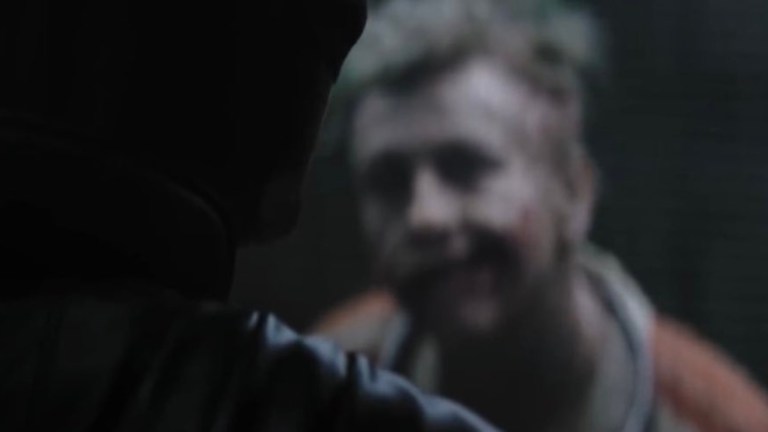The Batman: When Does the Joker Deleted Scene Take Place in the Movie?
Barry Keoghan brings to life a new version of the Joker in not one but two scenes in The Batman. But where does his deleted scene fit into the film?

Much has already been written about The Batman‘s biggest surprise. In fact, Warner Bros. even let the clown out of the bag early in the film’s theatrical run, revealing that director Matt Reeves had shot not just one scene with Barry Keoghan‘s new take on the Joker but two. The second scene was cut for time, though, and who could blame the director? This film is already just shy of three hours long, a superhero epic that, while excellent, isn’t exactly as jovial or action-packed as other comic book flicks fighting at that weight, and the extra scene is very talk-y and might have slowed down the movie just a tad too much.
But if you want to watch the scene anyway, you’re in luck. WB released the deleted scene ahead of the movie’s drop on HBO Max, giving us a deeper look into this Batman‘s relationship with the Clown Prince of Crime. While the scene that was kept in the movie shows us that Reeves’ Gotham does indeed feature a Joker, it’s this deleted scene that finally reveals that this clown has already had a run-in with the Bat. It seems to be the reason he was locked up in Arkham Asylum in the first place. In fact, this scene shows that many of the trademark elements of their relationship are already in place. It’s clear in just these five minutes that hero and villain are doomed to orbit each other forever. As the Joker says, they’re about to celebrate one of many anniversaries to come.
Watch the scene for yourself below:
No, your eyes aren’t deceiving you. Batman has come to Joker for help. The Riddler is leaving a trail of bodies and letters to the Dark Knight in his wake, and the Caped Crusader wants to know why. What better way to profile and track down a serial killer than to consult with other criminals who are just like him? But while this scene would feel right at home in the films of David Fincher, which heavily influenced The Batman, it actually plays more like the Hannibal Lecter scenes in Michael Mann’s Manhunter and Jonathan Demme’s The Silence of the Lambs, with Joker playing the role of the mad doctor who is one step ahead and toying with the detective.
Not only is the scene potentially setting up a future showdown between the Bat and the Clown in a potential sequel, but it foreshadows quite a few things about events later in the movie, such as the Riddler’s feelings of camaraderie with Batman and his animosity towards the Wayne family, who may or may not have been responsible for his father’s death decades prior. (We never truly learn whether Paul Dano’s Edward Nashton is supposed to actually be Thomas Elliot, but the movie strongly hints this is the case).
But since this is a deleted scene, where exactly does it fit in the movie? At what point in Batman’s investigation of the Riddler and Gotham’s most corrupt citizens does he decide that it’s time to visit his archnemesis?
Well, context clues suggest it happens midway through the first act. In the scene, the Joker mentions the commissioner and the mayor as the Riddler’s victims so far. Both Mayor Don Mitchell Jr. (Rupert Penry-Jones) and Commissioner Pete Savage (Alex Ferns) die early in the film. Meanwhile, the very high-profile death of Gil Colson (Peter Sarsgaard) isn’t mentioned in the scene, which suggests it hasn’t happened yet. This means the scene must take place before Batman sends Selina Kyle (Zoë Kravitz) into the Iceberg Lounge to spy on Gotham’s drug-addicted district attorney, who is later kidnapped by the Riddler that same night. The next day, Riddler straps a bomb to Colson’s chest and blows him up inside a church. Surely, the Joker would’ve mentioned that if it had already happened! He might have even fallen over laughing.
Okay, with that particular mystery solved, the other big question still remains: what do these two Joker scenes mean for the future of the villain in Reeves and Pattinson’s Gotham?
“As to whether we would actually do the Joker in future movies…his appearance at the end of the movie is really more contextual,” Reeves told us ahead of the film’s release. “I can’t say whether we would do him specifically in the movies or not. But if we do, I had a whole sort of backstory on what his genesis was and what that was about.”
Reeves gave us a look into that backstory during our interview, explaining that this Elephant Man-inspired take on the Joker is heavily informed by his deformities, which have shaped him into who he becomes.
“I’m a huge David Lynch fan,” Reeves said. “What if this guy’s whole worldview was formed by the fact that life had played this cruel trick on him? Life made a joke out of him and he could never not smile and he had a lifetime of people staring at this grotesque smile that he had no control over. [So] instead of being like the story of The Elephant Man, where all of his grotesque outward appearance belied the beautiful inside, this would form [Joker’s] nihilistic worldview. He would have a kind of insidious understanding of human nature and everything was framed through that lens of fate playing a cruel joke on you from childhood. So that’s kind of where the psychology comes from, in who this guy would be.”
That’s certainly a different take on the Clown Prince of Crime. And who knows, we might even get to see more of it in the future. But for now, you can check out The Batman on HBO Max or in theaters.
